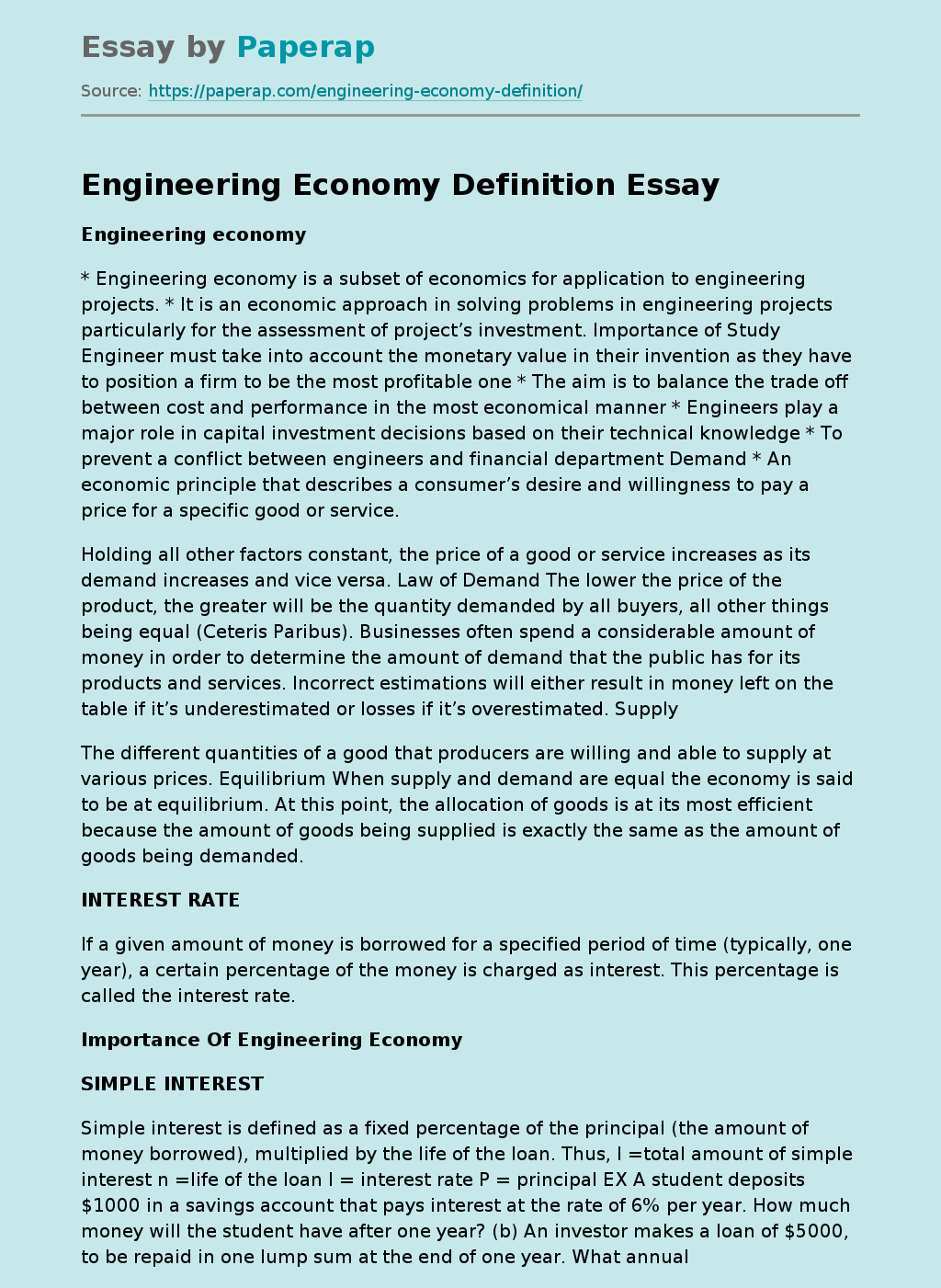Engineering Economy Definition
Engineering economy
* Engineering economy is a subset of economics for application to engineering projects. * It is an economic approach in solving problems in engineering projects particularly for the assessment of project’s investment. Importance of Study Engineer must take into account the monetary value in their invention as they have to position a firm to be the most profitable one * The aim is to balance the trade off between cost and performance in the most economical manner * Engineers play a major role in capital investment decisions based on their technical knowledge * To prevent a conflict between engineers and financial department Demand * An economic principle that describes a consumer’s desire and willingness to pay a price for a specific good or service.
Holding all other factors constant, the price of a good or service increases as its demand increases and vice versa. Law of Demand The lower the price of the product, the greater will be the quantity demanded by all buyers, all other things being equal (Ceteris Paribus).
Businesses often spend a considerable amount of money in order to determine the amount of demand that the public has for its products and services. Incorrect estimations will either result in money left on the table if it’s underestimated or losses if it’s overestimated. Supply
The different quantities of a good that producers are willing and able to supply at various prices. Equilibrium When supply and demand are equal the economy is said to be at equilibrium. At this point, the allocation of goods is at its most efficient because the amount of goods being supplied is exactly the same as the amount of goods being demanded.
INTEREST RATE
If a given amount of money is borrowed for a specified period of time (typically, one year), a certain percentage of the money is charged as interest. This percentage is called the interest rate.
Importance Of Engineering Economy
SIMPLE INTEREST
Simple interest is defined as a fixed percentage of the principal (the amount of money borrowed), multiplied by the life of the loan. Thus, I =total amount of simple interest n =life of the loan I = interest rate P = principal EX A student deposits $1000 in a savings account that pays interest at the rate of 6% per year. How much money will the student have after one year? (b) An investor makes a loan of $5000, to be repaid in one lump sum at the end of one year. What annual interest rate corresponds to a lump-sum payment of $5425?
The student will have his original $1000, plus an interest payment of 0. 06 x $1000 = $60. Thus, the student will have accumulated a total of $1060 after one year (b) The total amount of interest paid is $5425 – $5000 = $425. Hence the annual interest rate is TO FIND FUTURE VALUE F = P + I = P (l + n i) EX A student borrows $3000 from his uncle in order to finish school. His uncle agrees to charge him simple interest at the rate of 5% per year. Suppose the student waits two years and then repays the entire loan. How much will he have to repay? F = $3000[1+ (2)(0. 05)] = $3330.
COMPOUND INTEREST
During a given interest period, the current interest is determined as a percentage of the total amount owed If there are n interest periods, we have EX A student deposits $1000 in a savings account that pays interest at the rate of 6% per year, compounded annually. If all of the money is allowed to accumulate, how much will the student have after 12 years? Compare this with the amount that would have accumulated if simple interest had been paid.
INFLATION
National economies frequently experience inflation, in which the cost of goods and services increases from one year to the next
A = annual inflation rate (expressed as a decimal) n = number of years Ex An economy is experiencing inflation at the rate of 6% per year. An item presently costs $100. If the 6% inflation rate continues, what will be the price of this item in five years? An economy is experiencing inflation at an annual rate of 6%. If this continues, what will $100 be worth five years from now, in terms of today’s dollars?
INFLATION + INTEREST TAXES
In most situations, the interest that is received from an investment will be subject to taxation.
TAXES + INTERSET + INFLATION F = P (1 + )n EX
Suppose the engineer is in the 32% tax bracket, and is likely to remain there throughout the lifetime of the certificate. If inflation continues at the rate of 6% per year, what will be the value of his investment, in terms of today’s dollars, when the certificate matures? Let us assume that the engineer is able to invest the entire $10 000 in a savings certificate and that the 32% tax bracket includes all federal, state, and local taxes. Interest rate = 8 % GOOD LUCK
Engineering Economy Definition. (2019, Dec 05). Retrieved from https://paperap.com/engineering-economy-definition/

